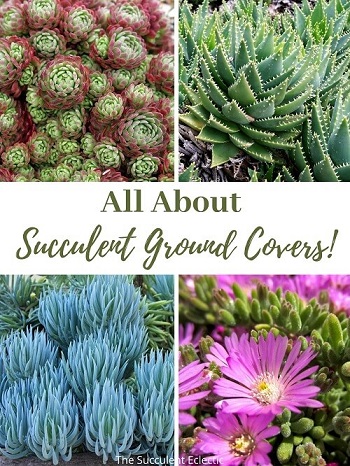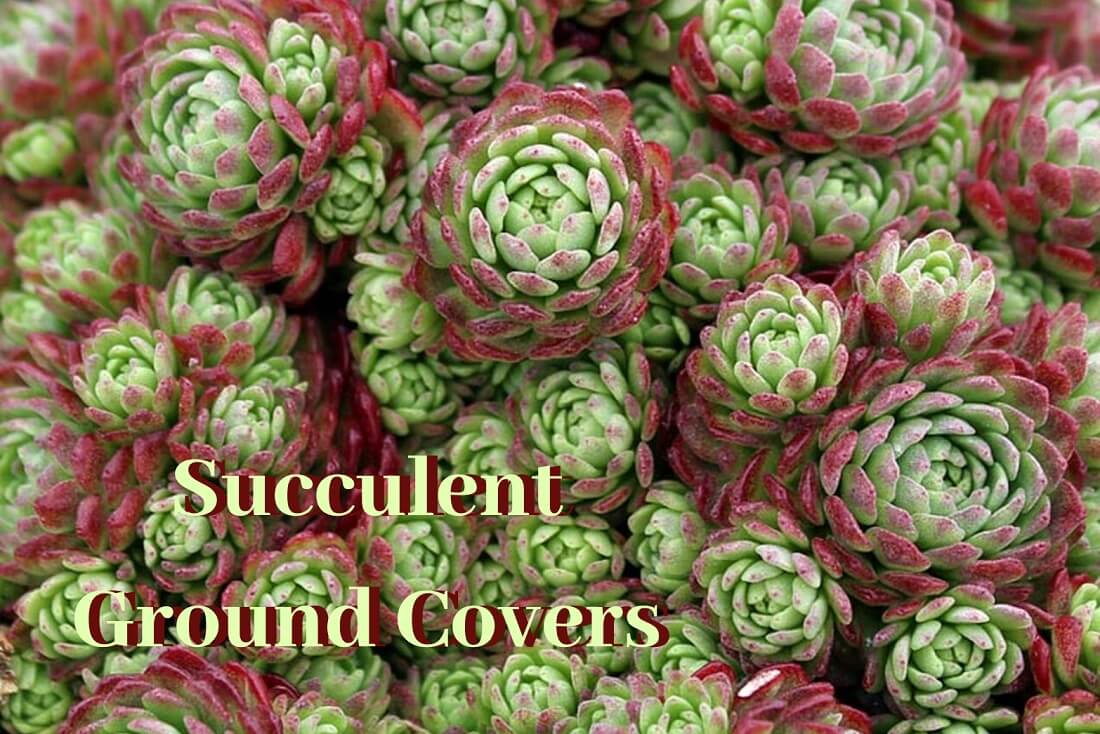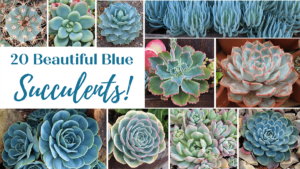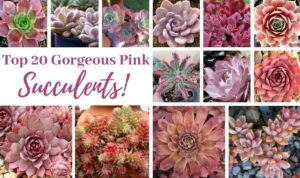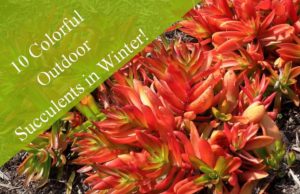Many people grow succulents strictly indoors or just in small containers on the patio. But these are wonderful plants that have evolved over many thousands of years, growing in a wide range of habitats. Succulents make handsome additions to the landscape in many roles, including focal points, borders, and living fences. Succulent ground cover provides a number of solutions in the garden. These are drought-tolerant ground covers that keep weeds down in open spaces. There are great varieties that provide color and texture year-round. Some have beautiful blooms, others do well in shade, and some attract and feed pollinators. Some are exceptionally cold hardy and thrive in climates with frigid winters. Read on to learn all about 10 great ground cover succulents and how to use them!
Top 10 Drought-Tolerant Ground Covers
In this Post We'll Cover:
{Please note, some links in this post may be affiliate links to sites that pay me a small commission if you click on the link and make a purchase. This commission is at absolutely no cost to you. I only recommend products and companies that I have worked with and truly love! ~Kat}
This is a looong post because there’s a lot to cover here. Skip ahead if you need to. We’ll cover:
- What is a Ground Cover?
- How to Plant a Succulent Ground Cover
- Top 10 Succulent Ground Covers
- Sedum album
- Senecio mandraliscae
- Sempervivum arachnoideum
- Aloe brevifolia
- Delosperma cooperi
- Jovibarba globifera
- Cremnosedum ‘Little Gem’
- Prometheum serpentinicum
- Orostachys iwarenge
- Crassula pellucida variegata ‘Calico Kitten’
What is a Ground Cover?
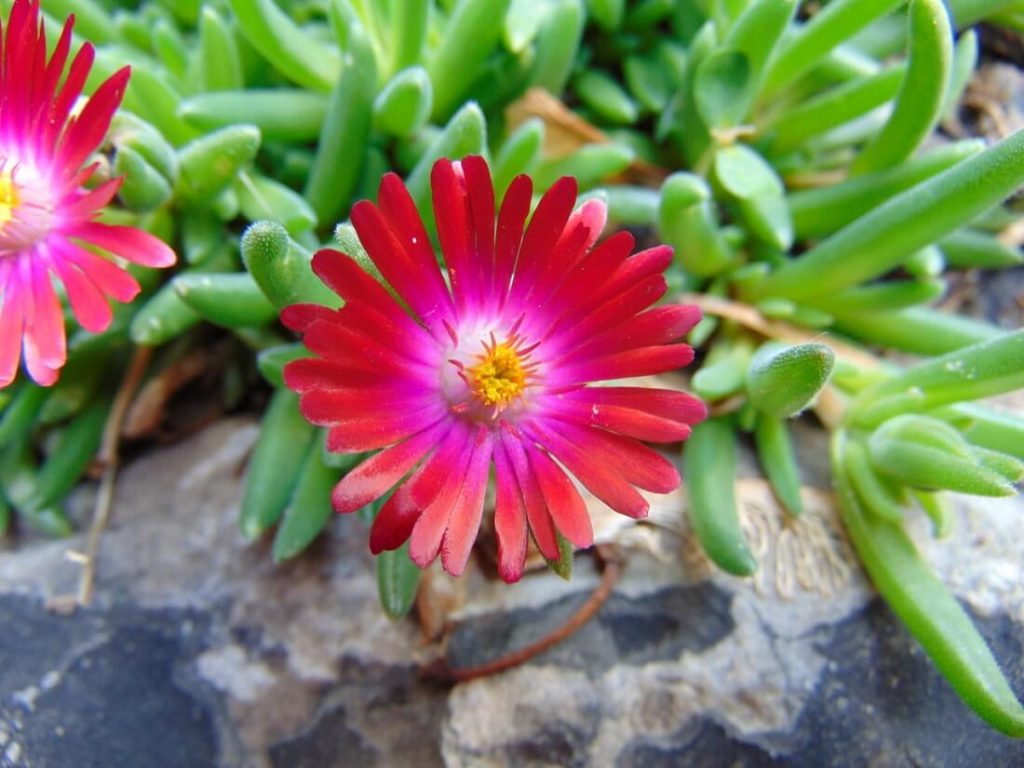
Plants can fill many functions in garden design. A large, spectacular specimen makes a focal point. Some form borders or even living fences. Low-growing plants that spread can be used as ground covers that cover bare earth with lush, growing foliage. A grass lawn is classic but takes a lot of work, water, and plenty of sunshine. When you’re looking for a ground cover for shade or with colorful foliage or flowers for year-round interest, or if deer are a problem in your area, consider planting a succulent ground cover.
The benefits of low-growing ground cover are plentiful. It softens the lines of the hardscape in the garden, like pathways and retaining walls. Ground cover plants also tie the look of the garden together and create a sense of harmony and serenity. Beyond aesthetics, a ground cover keeps the weeds down and prevents soil erosion. When you choose a succulent ground cover, you also enjoy perks like fire resistance and flowers that attract pollinators to the garden.
When classifying plants as ground covers, some people include plants that grow thigh-high or individual specimen plants, which seems confusing to me. For this post, we’ll just be looking at low-growing succulents that spread to form dense mats of foliage. Whether you use them as low-maintenance lawn substitutes or to cover a slope, to trickle through a dry stream bed, or growing in a rock garden, these are stellar ground cover succulents.
How to Plant a Succulent Ground Cover
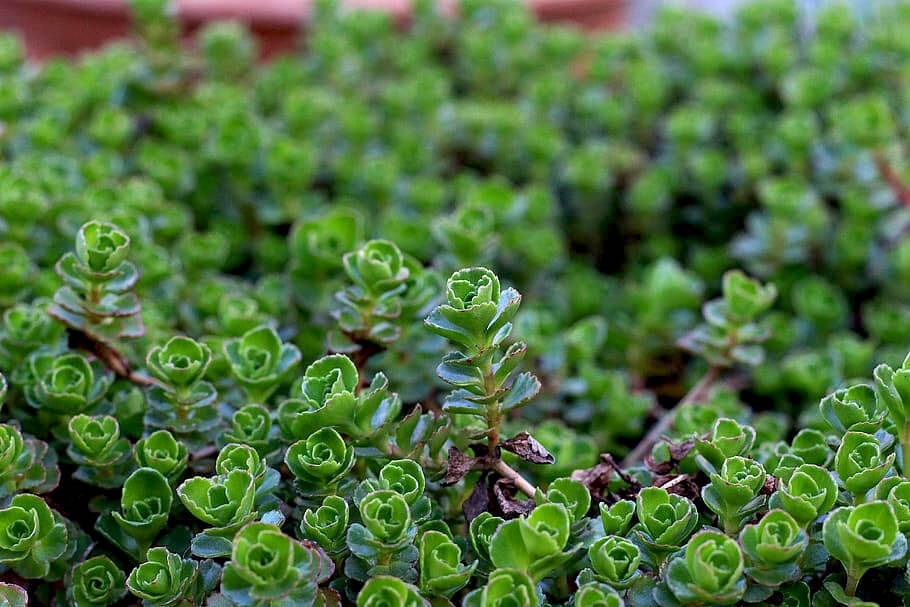
When planning out your succulent ground cover, don’t skimp on the number of plants needed to give you a thick, lush coverage. This will translate to much less work down the road. Weed out the area thoroughly. Break up compacted soil and work plenty of pumice or coarse sand (never fine sand!) into the soil to improve its drainage. Add 1/3 – 1/2 cup of dry worm castings per square foot of planting bed. Work the worm castings into the top 3 inches of the soil. This will both feed your plants and prevent mealybugs and other insects from damaging your plants.
Select the ground cover succulents that suit your climate and planting site. Check for varieties that are hardy in your area. Be sure to select those that will thrive in the lighting conditions in your specific planting bed. Then, follow the basic procedure for planting succulents. Slip the plants from their containers and gently break up the root ball. Dig a hole and insert the roots so they spread out and down. Plant the succulent at the same depth as the soil line in its container. Backfill with the soil that has pumice and worm castings mixed in. Cover the roots and tamp down the soil to collapse any air pockets. Wait a few days before watering in your ground cover to allow the roots to heal from any bruising and tears.
As you plant your ground cover, include stepping stones as needed. Succulent ground covers don’t tolerate a lot of foot traffic, so plan ahead.
Top 10 Succulent Ground Covers:
It’s a challenge to choose 10 great succulent ground covers to give you a good overview. There are more than 10 great choices among just Sedum or Sempervivum alone, while some genera have just a few good choices. I decided to give you as broad an overview as possible, so each entry on this list is from a different genus. Still, each succulent listed here is a stellar performer as a ground cover.
Sedum Album
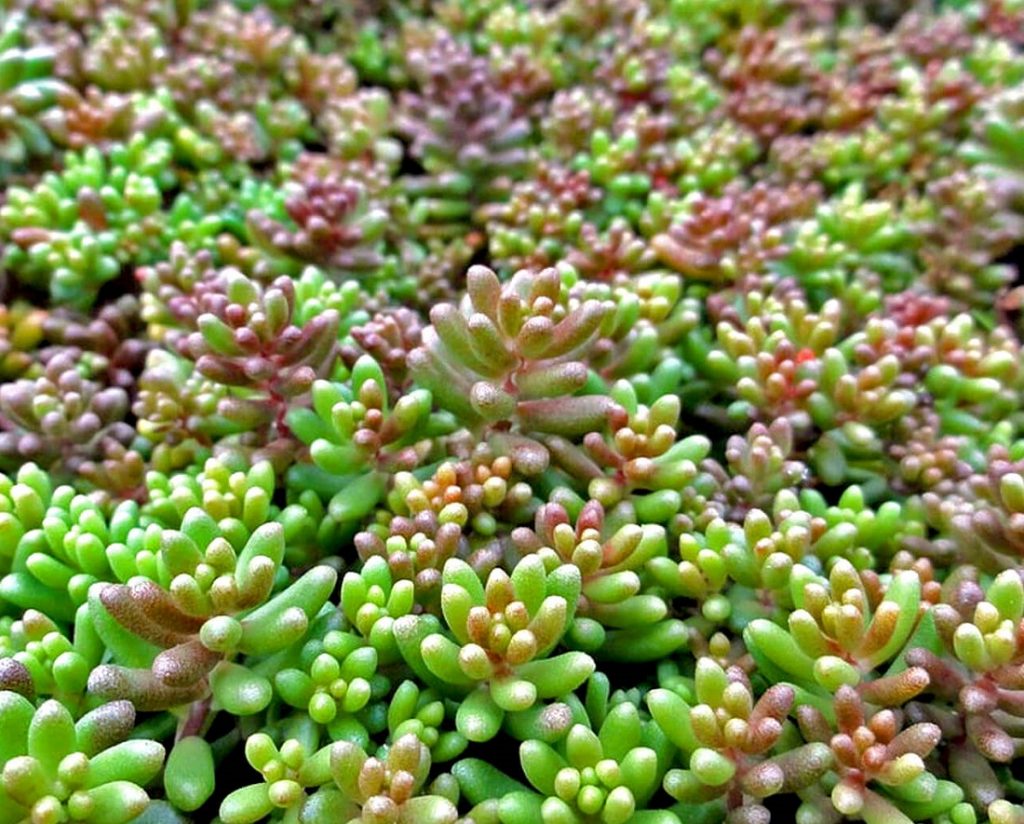
There are so many low-growing Sedum and stonecrops that make stellar choices for succulent ground cover I may have to do a separate post just for them! I chose Sedum album for this list because it has so many sterling qualities. The jellybean-like leaves give it a whimsical charm in the garden or mixed arrangements. It thrives in full sun and turns brilliant red in summer and covers itself with tiny white, starry blooms in mid-summer. The flowers are highly attractive to pollinators.
Sedum album is not just a drought-tolerant ground cover; it is hardy down to a frigid zone 4 (-30°F / -34°C). It is also a deer-resistant ground cover — not toxic to deer and rabbits, just unpalatable.
Senecio Mandraliscae
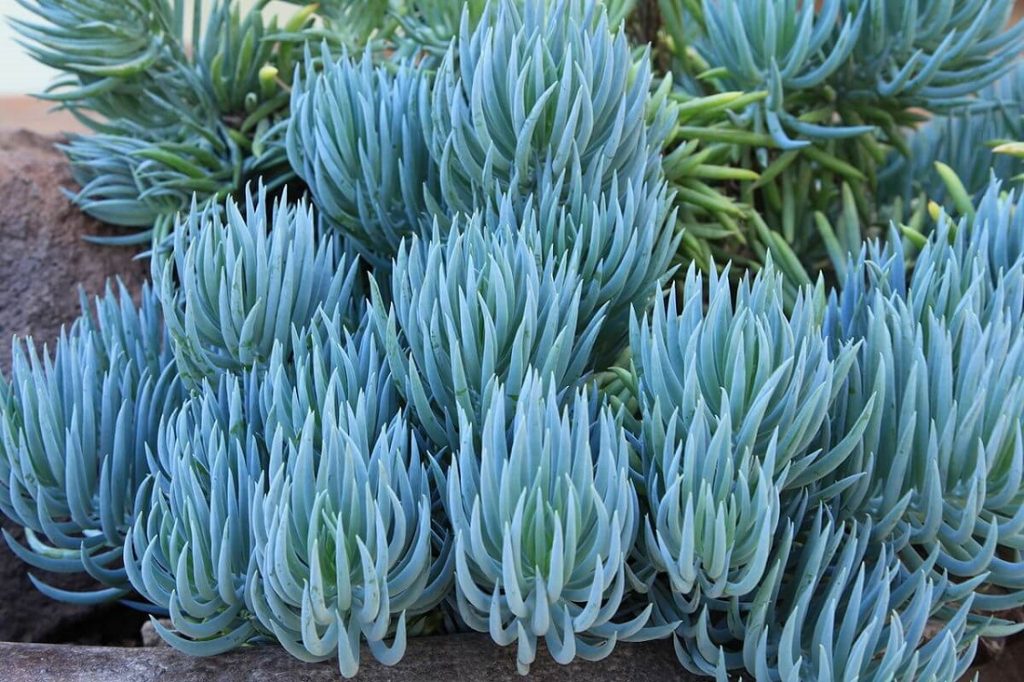
Senecio come in a wide range of colors, shapes, and sizes. Senecio mandraliscae, commonly called “blue chalk sticks,” is another drought-tolerant ground cover for full sun locations. Fleshy, finger-like leaves are silvery in shady spots, but with full summer sun, they turn a true blue rarely seen in foliage. They form dense mats of leaves 3-4″ tall. The color is especially effective paired with succulents or other plants that flush bright orange or red.
Senecio mandraliscae is hardy just in zones 9-11. It tolerates frost and temperatures down to 20°F (-6.7°C). Blue chalk sticks make a deer-resistant ground cover.
Sempervivum Arachnoideum
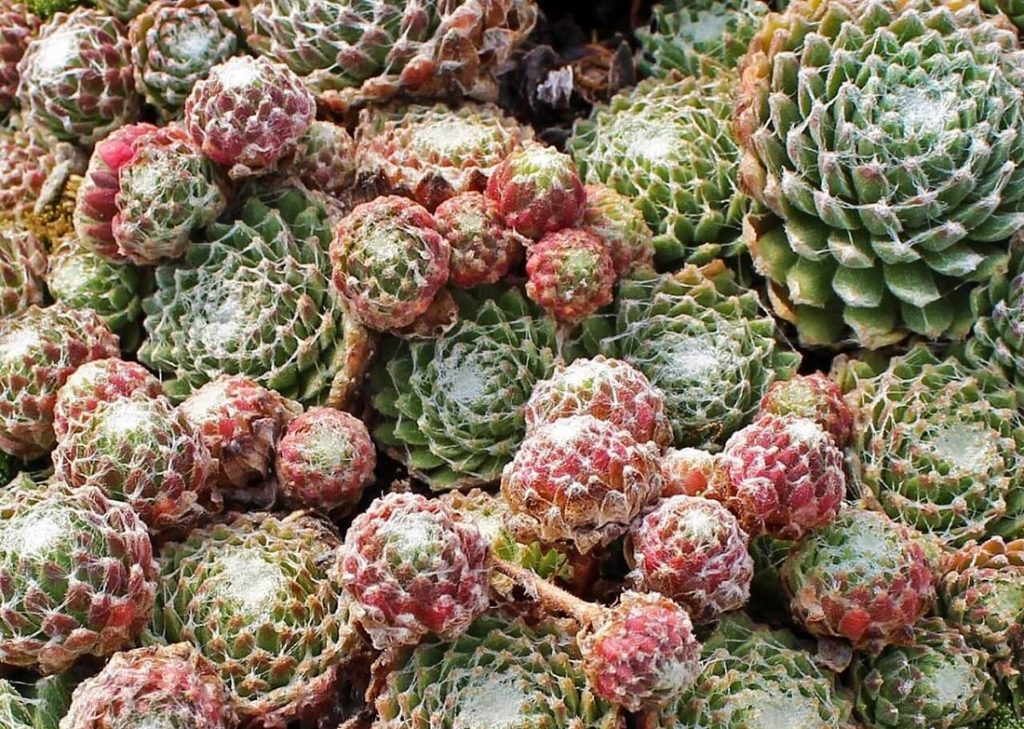
Sempervivum make a stellar succulent ground cover. All form dense mats of hens and chicks. Sempervivum arachnoideum have an intricate crisscrossing of fine hair-like filaments called trichomes. These trichomes look like cobwebs, giving these semps their common name. The trichomes prevent ice crystals from forming between the rosettes. They also break up the airflow over the rosette, protecting the plant from drying out. The filaments also collect dew, directing it to the plant to maximize its use of the available water. Sempervivum grow well in full sun to filtered shade. They go dormant in summer and grow lush again come fall.
There are a number of Sempervivum arachnoideum varieties, some are quite colorful. All are hardy to at least zone 5 (-15°F / -26°C) and some to much colder temps. You’ll love Sempervivum, but Bambi and Thumper will just walk on by.
Aloe Brevifolia
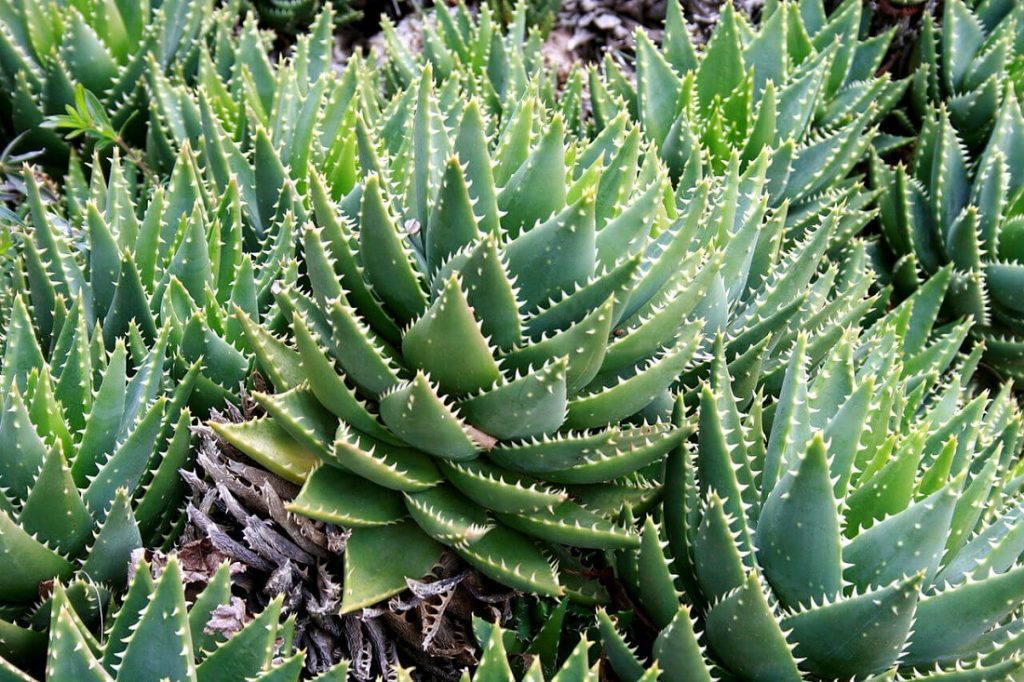
Aloe varieties go far beyond the famous and healing Aloe vera. In mild climates, Aloe brevifolia can form a stunning ground cover. The teeth along the blue-green leaves look fiercer than they feel and are simply wonderful when backlit by the sun. When grown in partial sun to filtered shade, this succulent ground cover maintains a lovely blue-green shade. In full sun, the leaves develop a scarlet flush. In late spring, tall spires of hot orange tubular flowers float above the Aloe rosettes, beckoning to all the local hummingbirds.
Aloe brevifolia is hardy just to zone 10 (30°F / -1°C). In all other climates, bring this beauty indoors over the winter. This drought-tolerant ground cover plant is also highly resistant to deer.
Delosperma Cooperi
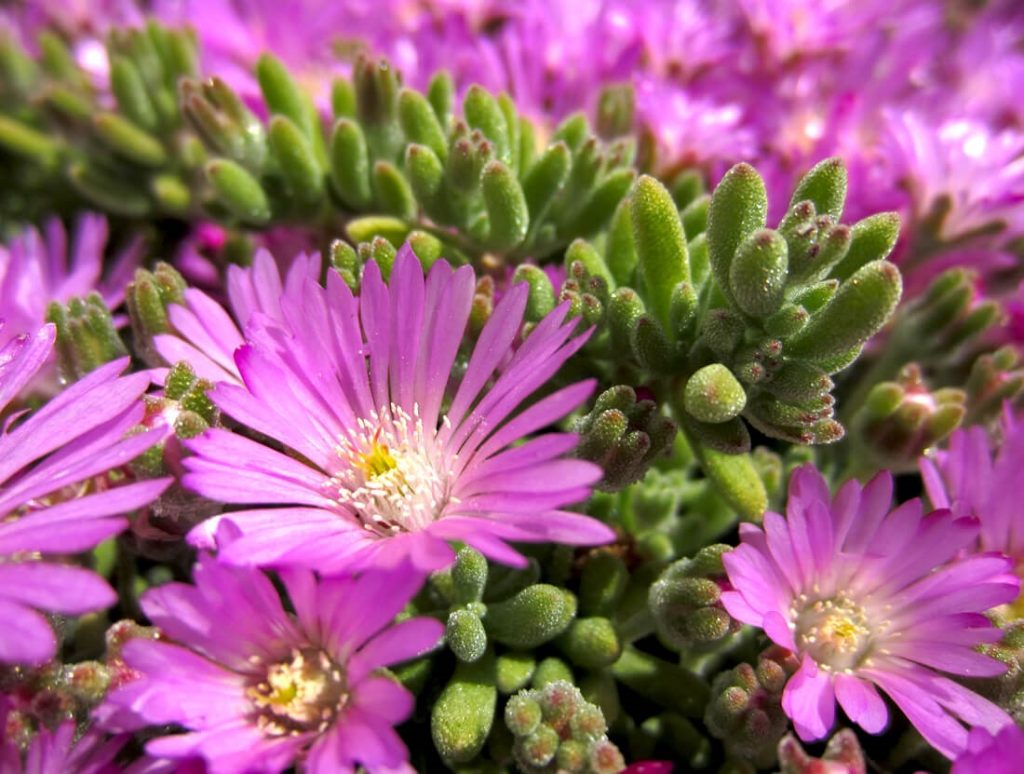
Delosperma is an old-fashioned favorite. Delosperma cooperi, better known as the beloved ice plant, covers itself with hot pink blooms from mid-summer through mid-autumn. Delosperma will even tolerate light foot traffic, though I still recommend using stepping stones. This trailing ice plant is also a great choice for hanging baskets or containers of mixed succulents where it spills over the edge of the container. For best performance, grow ice plant in full sun.
Delosperma cooperi is hardy to zone 6 (-10°F / -23 °C). This flowering ground cover is attractive to bees and butterflies yet nicely resistant to deer and rabbits.
Jovibarba Globifera
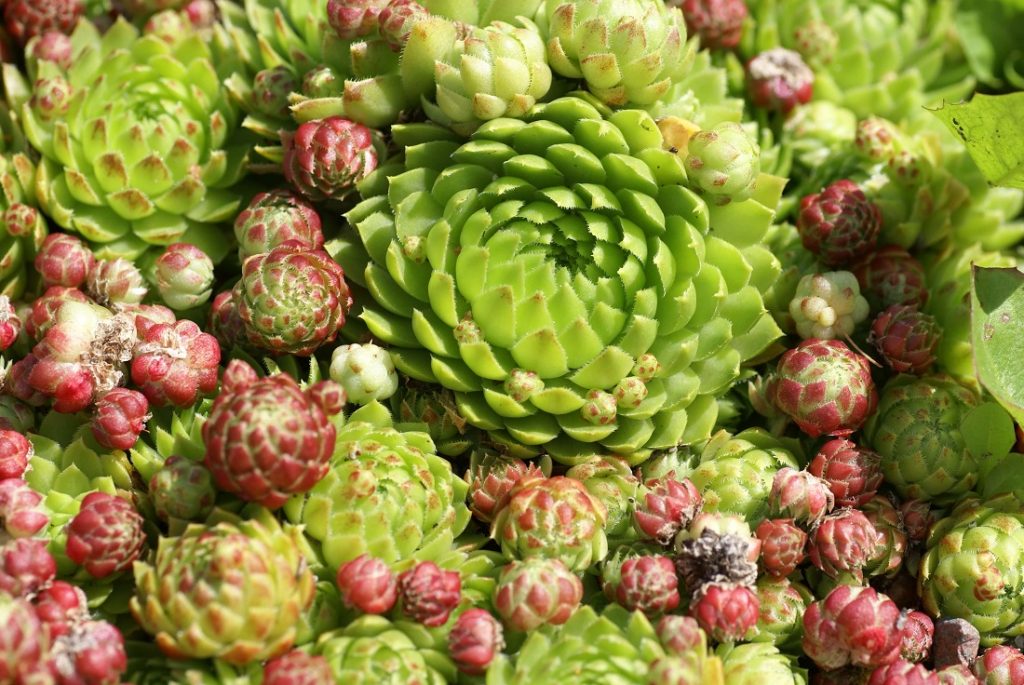
Jovibarba is an intriguing genus closely resembling Sempervivum
Jovibarba is an intriguing genus closely resembling Sempervivum. Jovibarba globifera (syn Sempervivum globiofera) is a charming, cold-hardy succulent ground cover that so closely resembles Sempervivum, the two are often confused or combined. What sets this Jovibarba apart is the way it forms its offsetsSucculent offsets are the baby succulents that form at the b.... The globe-shaped baby plants stay tightly curled up, like little marbles. When the stem-like stolons that attach the babies to the mother plant dry up and snap, the baby simply rolls away to find a new patch of soil to set down roots in. This characteristic leads to the common name of “rollers” or “roll-aways”.
Jovibarba globifera varieties vary in their coloring. All are cold hardy down to at least zone 5 (-15°F / -26°C), and some much colder. Roll-aways and, in fact, all Jovibarba are excellent as deer-resistant ground cover plants. Plant them in full sun to partial shade.
Cremnosedum ‘Little Gem’
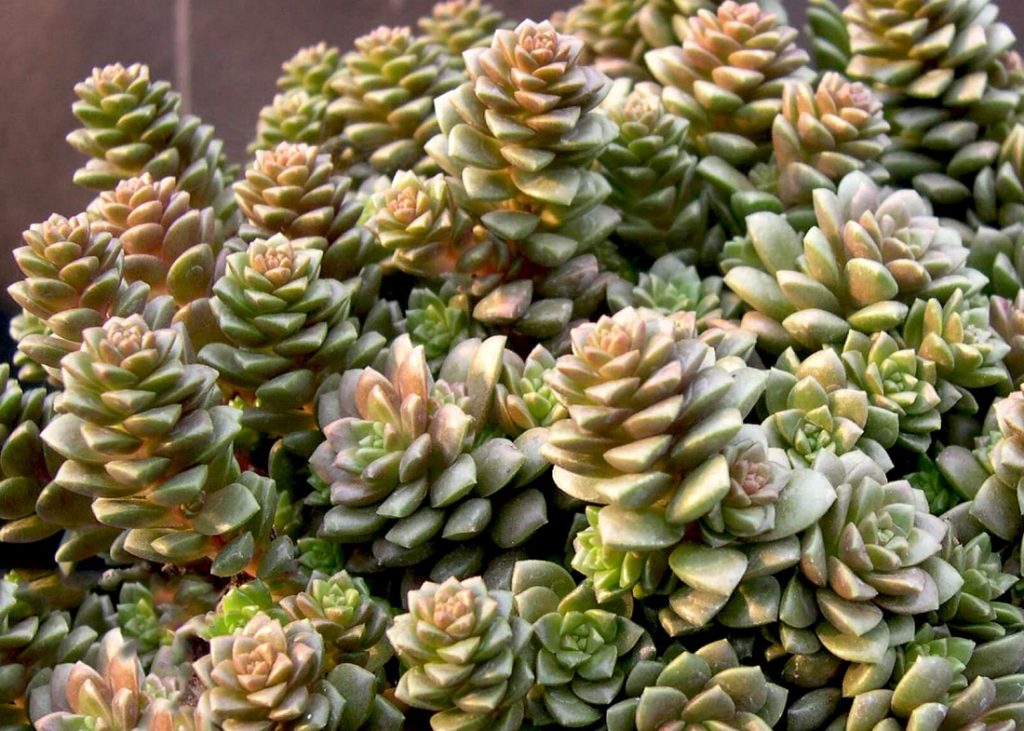
Cremnosedum ‘Little Gem’ is the celebrated hybrid of Sedum humifusum and Cremnophila nutans. It’s a petite succulent ground cover with a big personality. Emerald green leaves form little stacking rosettes that develop a flush of bronze in summer sun. In early spring, Little Gem produces electric yellow star-like blooms. While it forms a dense mat of foliage, this flowering ground cover is also excellent for tucking into small, bare spots between larger plants. Cremnosedum Little Gem thrives in bright shade to full sun.
This flowering ground cover is hardy just to zone 9 (20°F / -6.7°C). But it is too lovely to miss in colder climates. Little Gem is wonderful in mixed arrangements that you can bring indoors over a cold winter!
Prometheum Serpentinicum
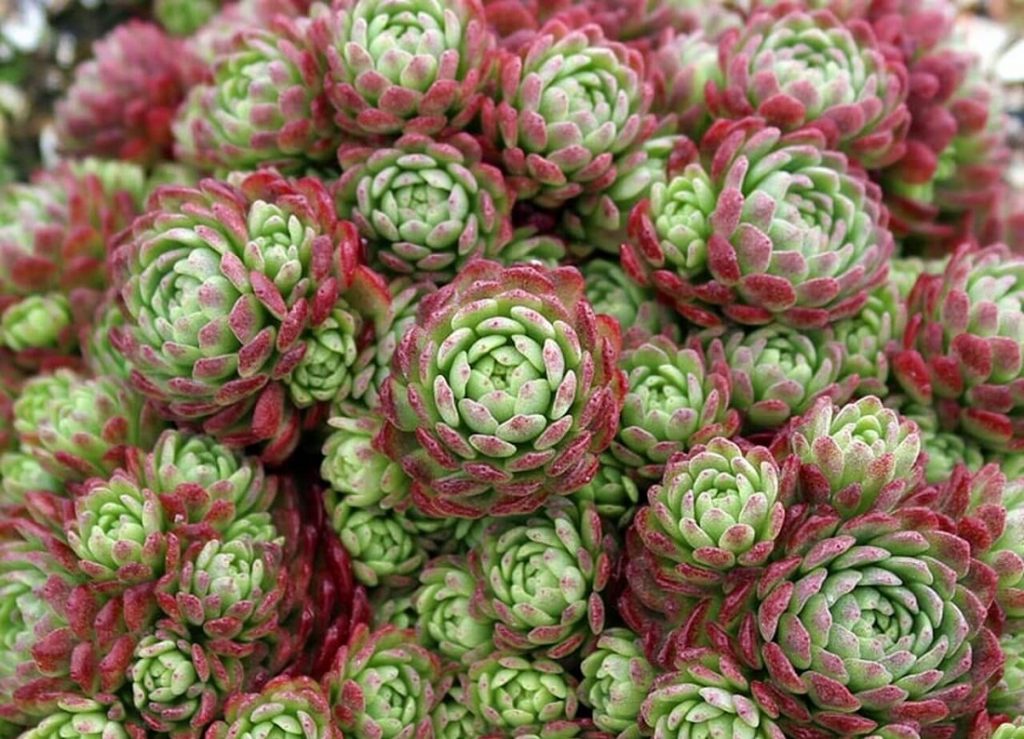
Prometheum is a small group of cold-hardy rosette succulents that until recently, were categorized as Rosularia, with a common name of Turkish hens and chicks. It’s hard to know why these beauties are not more widely grown. As it is, they are rare and only found at specialty succulent stores like Mountain Crest Gardens. Prometheum thrives in dappled or partial shade conditions. In late spring and summer, starry white and yellow flowers appear.
This deer-resistant ground cover is easy to grow and cold hardy down to zone 5 (-15°F / -26°C).
Orostachys Iwarenge
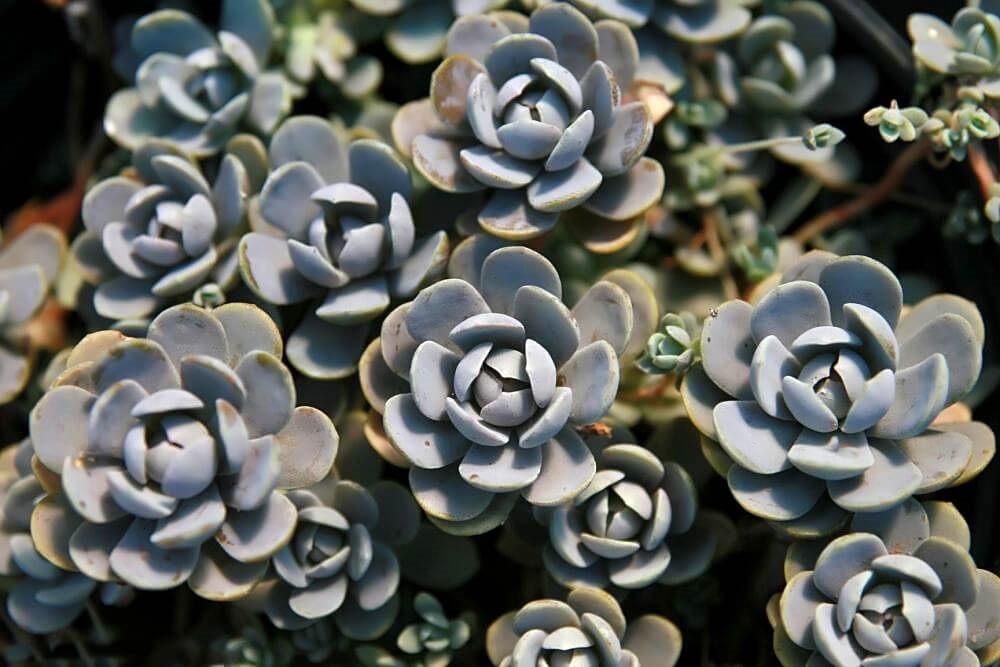
Orostachys is a genus made up of elegant, low-growing, and drought-tolerant ground cover. Rosettes of green or silver form dense mats that smother weeds. Orostachys malacophylla var. iwarenge is a cool silver that blends well with any color in the garden. While the rosettes are just 3 inches tall, they form conical spires of tiny blooms that reach 6-8″ tall, giving the plants an unusual appearance that leads to the common name of Chinese dunce caps. The flowers are attractive to both bees and butterflies, but deer and rabbits give it a miss.
Orostachys is cold hardy down to zone 6 (-10°F / -23 °C) and goes fully dormant in the winter. When snows thaw, they return in spring. This flowering ground cover grows best in full sun.
Crassula Pellucida Variegata ‘Calico Kitten’
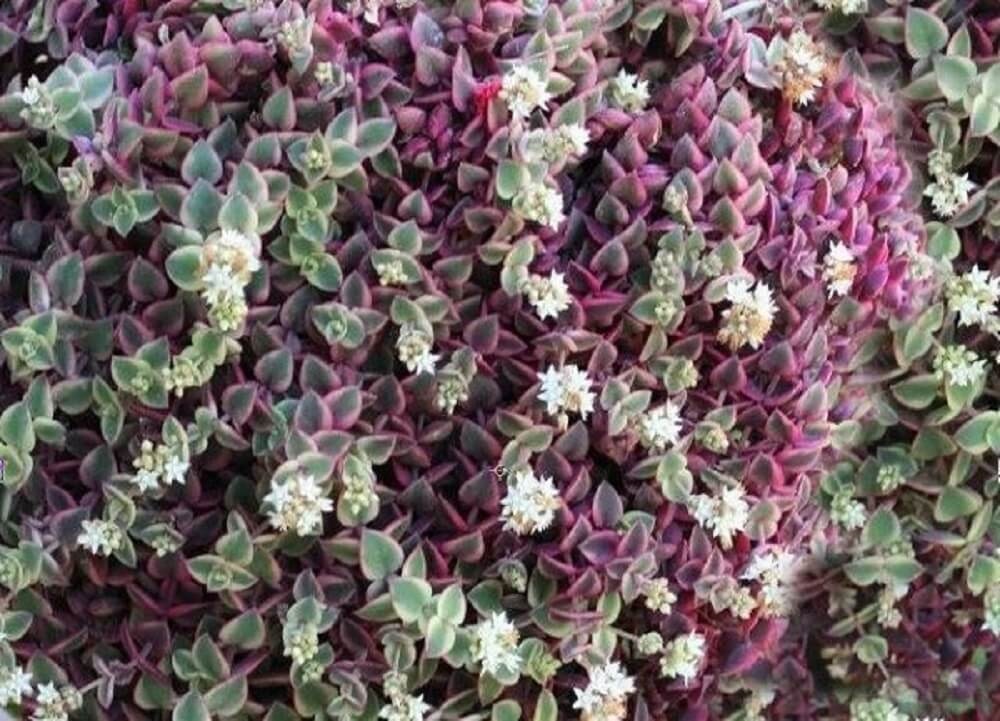
Crassula is a genus of succulents that range from large tree-like shrubs to lovely trailing varieties. Crassula pellucida variegata ‘Calico Kitten’ is a tender succulent that forms tiny, heart-shaped leaves with lovely variegation. In filtered light, each small leaf sports green and white with a pink margin. In more light, the pink grows deeper and much more pronounced. Still, partial sun to dappled shade is best for this little beauty. Creamy white blooms develop in spring and are attractive to bees and butterflies. This succulent ground cover is excellent for large spaces or tucked into small spots between larger plants. In hanging baskets or mixed arrangements, the colorful hearts tumble over the edge of the container.
Crassula ‘Calico Kitten’ is hardy just to zone 10 (30°F / -1.1°C). But it is too lovely to be missed in colder climates! Over-winter indoors and return to the garden come spring.
Whew! There you have it, my guide to succulent ground covers, including 10 stellar varieties. What do you think? Will you be planting a ground cover? Would you be interested in a post focused on Sedum ground covers? Do you have one of these varieties in your garden? I would love to know! Please take a moment to leave a comment. I’ll get right back to you!
Happy Gardening!

P.S. For more succulent information, please subscribe to The Succulent Eclectic! I’ll send you my FREE e-course, 7 Steps to Succulent Success!
P.P.S. Why not join my Facebook Group for succulent-lovers? We talk succulent care, propagation, succulent identification, and design. It’s a warm and welcoming group that would love to meet you!
